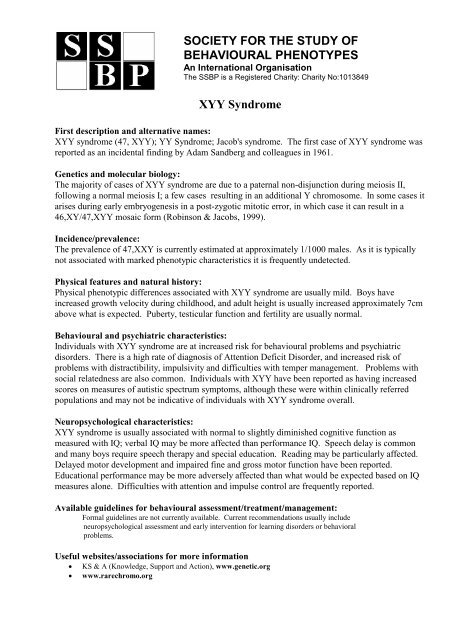XYY Syndrome - Society for the Study of Behavioural Phenotypes
XYY Syndrome - Society for the Study of Behavioural Phenotypes
XYY Syndrome - Society for the Study of Behavioural Phenotypes
You also want an ePaper? Increase the reach of your titles
YUMPU automatically turns print PDFs into web optimized ePapers that Google loves.
<strong>XYY</strong> <strong>Syndrome</strong><br />
First description and alternative names:<br />
<strong>XYY</strong> syndrome (47, <strong>XYY</strong>); YY <strong>Syndrome</strong>; Jacob's syndrome. The first case <strong>of</strong> <strong>XYY</strong> syndrome was<br />
reported as an incidental finding by Adam Sandberg and colleagues in 1961.<br />
Genetics and molecular biology:<br />
The majority <strong>of</strong> cases <strong>of</strong> <strong>XYY</strong> syndrome are due to a paternal non-disjunction during meiosis II,<br />
following a normal meiosis I; a few cases resulting in an additional Y chromosome. In some cases it<br />
arises during early embryogenesis in a post-zygotic mitotic error, in which case it can result in a<br />
46,XY/47,<strong>XYY</strong> mosaic <strong>for</strong>m (Robinson & Jacobs, 1999).<br />
Incidence/prevalence:<br />
The prevalence <strong>of</strong> 47,XXY is currently estimated at approximately 1/1000 males. As it is typically<br />
not associated with marked phenotypic characteristics it is frequently undetected.<br />
Physical features and natural history:<br />
Physical phenotypic differences associated with <strong>XYY</strong> syndrome are usually mild. Boys have<br />
increased growth velocity during childhood, and adult height is usually increased approximately 7cm<br />
above what is expected. Puberty, testicular function and fertility are usually normal.<br />
<strong>Behavioural</strong> and psychiatric characteristics:<br />
Individuals with <strong>XYY</strong> syndrome are at increased risk <strong>for</strong> behavioural problems and psychiatric<br />
disorders. There is a high rate <strong>of</strong> diagnosis <strong>of</strong> Attention Deficit Disorder, and increased risk <strong>of</strong><br />
problems with distractibility, impulsivity and difficulties with temper management. Problems with<br />
social relatedness are also common. Individuals with <strong>XYY</strong> have been reported as having increased<br />
scores on measures <strong>of</strong> autistic spectrum symptoms, although <strong>the</strong>se were within clinically referred<br />
populations and may not be indicative <strong>of</strong> individuals with <strong>XYY</strong> syndrome overall.<br />
Neuropsychological characteristics:<br />
<strong>XYY</strong> syndrome is usually associated with normal to slightly diminished cognitive function as<br />
measured with IQ; verbal IQ may be more affected than per<strong>for</strong>mance IQ. Speech delay is common<br />
and many boys require speech <strong>the</strong>rapy and special education. Reading may be particularly affected.<br />
Delayed motor development and impaired fine and gross motor function have been reported.<br />
Educational per<strong>for</strong>mance may be more adversely affected than what would be expected based on IQ<br />
measures alone. Difficulties with attention and impulse control are frequently reported.<br />
Available guidelines <strong>for</strong> behavioural assessment/treatment/management:<br />
Formal guidelines are not currently available. Current recommendations usually include<br />
neuropsychological assessment and early intervention <strong>for</strong> learning disorders or behavioral<br />
problems.<br />
Useful websites/associations <strong>for</strong> more in<strong>for</strong>mation<br />
• KS & A (Knowledge, Support and Action), www.genetic.org<br />
• www.rarechromo.org<br />
SOCIETY FOR THE STUDY OF<br />
BEHAVIOURAL PHENOTYPES<br />
An International Organisation<br />
The SSBP is a Registered Charity: Charity No:1013849
References<br />
1. Aksglaede L., Skakkebaek N. , & Juul A. (2008) Abnormal sex chromosome constitution and longitudinal growth:<br />
Serum levels <strong>of</strong> insulin-like growth factor (IGF)-1, IGF binding protein-3, luteinizing hormone, and testosterone in 109<br />
males with 47,XXY, 47,<strong>XYY</strong>, or sex-determining region <strong>of</strong> <strong>the</strong> y chromosome (SRY)-positive 46,XX karyotypes. J Clin<br />
Endocrin Metab 93,169-176.<br />
2. Geerts M., Steyaert J., Fryns J. (2003) The <strong>XYY</strong> syndrome: a follow-up study on 38 boys. Genet Counsel 14, 267-<br />
279.<br />
3. Leggett V., Jacobs P., Nation K., et al. (2010) Neurocognitive outcomes <strong>of</strong> individuals with a sex chromosome<br />
trisomy: XXX, <strong>XYY</strong>, or XXY: a systematic review. Dev Med Child Neurol 52, 119-129.<br />
4. Robinson D.O., & Jacobs P.A. (1999) The origin <strong>of</strong> <strong>the</strong> extra Y chromosome in males with a 47, <strong>XYY</strong> karyotype. Hum<br />
Mol Genet 8(12), 2205-9.<br />
5. Ross J., Zeger M., Kushner H., et al. (2009) An extra X or Y chromosome: contrasting <strong>the</strong> cognitive and motor<br />
phenotypes in childhood in boys with 47,<strong>XYY</strong> syndrome or 47,XXY Klinefelter <strong>Syndrome</strong>. Dev Disabil Res Rev 15,<br />
309-317.<br />
6. Visootsak J., Graham J. (2009) Social function in multiple X and Y chromosome disorders: XXY, <strong>XYY</strong>, X<strong>XYY</strong>,<br />
XXXY. Dev Disabil Res Rev 15, 328-332.<br />
Rhoshel K Lenroot, 2010


